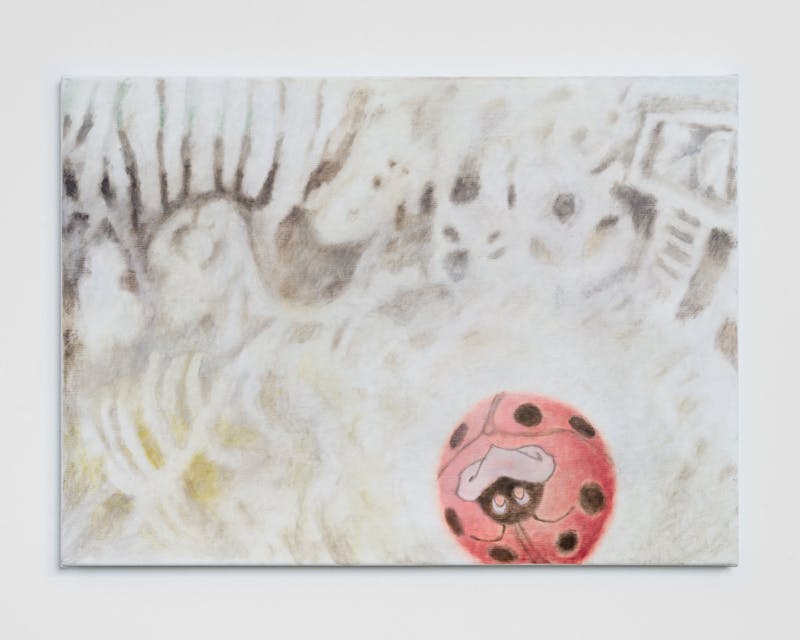Anyone who has a keen grasp of contemporary painting might have noticed the recent surge of Danes on to gallery programmes. We needn’t be too surprised – over the last century, Danish painters have more than made their mark on the art world: the likes of Asger Jorn, Ursula Reuter Christiansen and Per Kirkeby, for example. Danish-born, Copenhagen-based artists, Katrine Bobek, Martin Aagaard Hansen, Anders Davidsen and Bertil Osorio Heltoft are no different. As allies and innovators of their own burgeoning painting movement, each stir their brushes in the same cauldron, submerging the murky depths of nature and arriving at their own myths and tales.
Although their mark-making and iconography undoubtably differ, the surfaces share a common appreciation for the nature and wasteland surrounding their city: Katrine’s painted figures hide amongst muddy, impasto tones reminiscent of wet soil; Martin’s emerge out of chalky primed under-layers, blooming like mycelium; Anders’ dry, mottled seascapes leave behind faint cracks similar to the entwining roots from a tree; Bertil’s blurry, faint washes look sodden from a heavy rainfall. There is something, too, about their subjects’ movement – suspending life into revolving doors of fictions that mutate from painting to painting. Repeated motifs, swirling dream-like narratives and accreted layers bring heightened suspense, as if each exhibited composition surrenders another secret about a longer tale told over a lifespan.
The paintings are concocted in the same sort of way a raconteur tells a story – fuelled by memories of their own, or borrowed, or just made up. Vincent Van Gogh wrote that his ‘strokes come with a sequence and coherence like words in a speech or letter’, and poet Steven Spender remarked that ‘painters have used painting to realise their inner fantasies, to paint their dreams.’ All four painters here use their brushes as if writing words on a page and have writerly perceptions. ‘The Lurid Season’ is a verse from one of Martin’s poems, referring to the changing light across the seasons in Copenhagen, which to him is – paradoxically – ‘as alarming as it is beautiful.’ Both adjectives apply to the quartet’s paintings – figures and landscapes distilled under vibrant vistas. As avid admirers of one another’s work, they didn’t hesitate long in agreeing the exhibition’s name.

Bertil Osorio, Lost Ball Gardens, 2022
Katrine, Martin, Anders and Bertil accentuate the dichotomy between abstraction and realism. There are areas of their paintings which, at first glance, seem entirely non-representational but which, on closer viewing, reveal a hidden face or blurred form. Much of these decisions happen in the midst of painting, usurping plans and sketches made beforehand; in Katrine’s, numerous characters fight for attention in swirling tableaux reminiscent of recurring dreams, scenes toppling into one; Martin’s seemingly fluid abstractions disguise figures and insects that move through vacant houses, as poetic verses ‘This place, this trap’, ‘Wind rang’ dissipate into fog; Anders repeats the same phantom depiction of a seascape, casting each one under progressively more apocalyptic veils of dark red as childhood recollections merge with his reverie; Bertil’s figures blur into muffled forests of saturated colour, certain frivolities like a ball, a knife and a lunchbox coming into focus while others dissolve as if behind clouded glass.
These are paintings that resist a predictable ending. They tempt expectations, before removing it entirely just as a tidy resolution seems to come within our grasp. This prolonging of suspense characterises their collective endeavour – what begin as empty, withered canvases or boards, quickly bloom into mystic underworlds as layers are added or taken away. In ‘The Lurid Season’ expect twists and turns, but – as in the finest Scandinavian folklore – just as you find your way back to the path, it all unravels again.